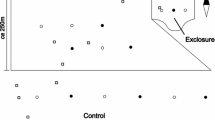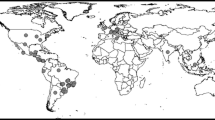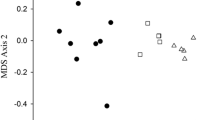Abstract
Context
Insect herbivores comprise the majority of macroinvertebrate communities of temperate grasslands and act as drivers for important ecosystem functions. Landscape- and local-level land use may alter species pools and dispersal possibilities and act as local environmental filters, affecting insect trait composition.
Objectives
While environmental filtering by local land use has repeatedly been shown to affect insect community assembly, less is known about the role of land-use intensity at the landscape level. We studied the relative importance of both local- and landscape-level land use in shaping the functional diversity and composition as well as the functional β-diversity among herbivore communities.
Methods
We used abundance data of three main herbivorous insect groups from grasslands across three regions in Germany and combined it with data on nine morphometric traits related to functions such as dispersal abilities to analyse the effects of different land-use components on community assembly.
Results
Land use at both the local and landscape level affected the functional composition of insect communities. Some trait combinations were particularly sensitive to changes in management intensity, whereas others reacted strongly to the availability of suitable habitats in the surrounding area. Simultaneously, functional diversity was not affected by land use at either spatial level. However, increasing local management intensity reduced functional β-diversity.
Conclusions
We conclude that both local- and landscape-level land use shape the functional composition of insect communities. Our results highlight the importance of considering land use across multiple spatial scales to understand its effects on the functional integrity of herbivore communities in temperate grasslands.




Similar content being viewed by others
References
Aubin I, Venier L, Pearce J, Moretti M (2013) Can a trait-based multi-taxa approach improve our assessment of forest management impact on biodiversity? Biodivers Conserv 22:2957–2975
Barton PS, Gibb H, Manning AD, Lindenmayer DB, Cunningham SA (2011) Morphological traits as predictors of diet and microhabitat use in a diverse beetle assemblage. Biol J Linn Soc 102:301–310
Bauer T, Kredler M (1993) Morphology of the compound eyes as an indicator of life-style in carabid beetles. Can J Zool 71:799–810
Birkhofer K, Gossner MM, Diekötter T, Drees C, Ferlian O, Maraun M, Scheu S, Weisser WW, Wolters V, Wurst S, Zaitsev AS, Smith HG (2017) Land-use type and intensity differentially filter traits in above- and below-ground arthropod communities. J Anim Ecol 86:511–520
Blüthgen N, Dormann CF, Prati D, Klaus VH, Kleinebecker T, Hölzel N, Alt F, Boch S, Gockel S, Hemp A, Müller J, Nieschulze J, Renner SC, Schöning I, Schumacher U, Socher SA, Wells K, Birkhofer K, Buscot F, Oelmann Y, Rothenwöhrer C, Scherber C, Tscharntke T, Weiner CN, Fischer M, Kalko EKV, Linsenmair KE, Schulze E-D, Weisser WW (2012) A quantitative index of land-use intensity in grasslands: integrating mowing, grazing and fertilization. Basic Appl Ecol 13:207–220
Börschig C, Klein A-M, von Wehrden H, Krauss J (2013) Traits of butterfly communities change from specialist to generalist characteristics with increasing land-use intensity. Basic Appl Ecol 14:547–554
Botta-Dukát Z (2005) Rao’s quadratic entropy as a measure of functional diversity based on multiple traits. J Veg Sci 16:533–540
Botta-Dukát Z, Czúcz B (2016) Testing the ability of functional diversity indices to detect trait convergence and divergence using individual-based simulation. Methods Ecol Evol 7:114–126
Brook AJ, Woodcock BA, Sinka M, Vanbergen AJ (2008) Experimental verification of suction sampler capture efficiency in grasslands of differing vegetation height and structure. J Appl Ecol 45:1357–1363
Burnham KP, Anderson DR (2004) Multimodel inference: understanding AIC and BIC in model selection. Sociol Methods Res 33:261–304
Burrows M, Sutton GP (2008) The effect of leg length on jumping performance of short- and long-legged leafhopper insects. J Exp Biol 211:1317–1325
Carmona CP, de Bello F, Mason NWH, Lepš J (2016) Traits without borders: integrating functional diversity across scales. Trends Ecol Evol 31:382–394
Chapman RF (2013) Simpson SJ, Douglas AE (eds) The insects: structure and function, 5th edn. Cambridge University Press, Cambridge
Compton SG (2002) Sailing with the wind: dispersal by small flying insects. In: Bullock JM, Kenward RE, Hails RS (eds) Dispersal ecology. Blackwell Science, Oxford, pp 113–133
R Core Team (2018) R: A language and environment for statistical computing. R Foundation for Statistical Computing, Vienna
Di Giulio M, Edwards PJ, Meister E (2001) Enhancing insect diversity in agricultural grasslands: the roles of management and landscape structure. J Appl Ecol 38:310–319
Dolédec S, Chessel D, ter Braak CJF, Champely S (1996) Matching species traits to environmental variables: a new three-table ordination method. Environ Ecol Stat 3:143–166
Dray S, Dufour A-B, Thioulouse J (2018) Analysis of ecological data: exploratory and euclidean methods in environmental sciences. R package version 1.7-11
Ferrier S, Manion G, Elith J, Richardson K (2007) Using generalized dissimilarity modelling to analyse and predict patterns of beta diversity in regional biodiversity assessment. Divers Distrib 13:252–264
Fischer M, Bossdorf O, Gockel S, Hänsel F, Hemp A, Hessenmöller D, Korte G, Nieschulze J, Pfeiffer S, Prati D, Renner S, Schöning I, Schumacher U, Wells K, Buscot F, Kalko EKV, Linsenmair KE, Schulze E-D, Weisser WW (2010) Implementing large-scale and long-term functional biodiversity research: the biodiversity exploratories. Basic Appl Ecol 11:473–485
Fountain-Jones NM, Baker SC, Jordan GJ (2015) Moving beyond the guild concept: developing a practical functional trait framework for terrestrial beetles. Ecol Entomol 40:1–13
Gámez-Virués S, Perović DJ, Gossner MM, Börschig C, Blüthgen N, de Jong H, Simons NK, Klein A-M, Krauss J, Maier G, Scherber C, Steckel J, Rothenwöhrer C, Steffan-Dewenter I, Weiner CN, Weisser W, Werner M, Tscharntke T, Westphal C (2015) Landscape simplification filters species traits and drives biotic homogenization. Nat Commun 6:8568
Gardiner T, Hill J (2006) A comparison of three sampling techniques used to estimate the population density and assemblage diversity of Orthoptera. J Orthoptera Res 15:45–51
Gossner MM, Lewinsohn TM, Kahl T, Grassein F, Boch S, Prati D, Birkhofer K, Renner SC, Sikorski J, Wubet T, Arndt H, Baumgartner V, Blaser S, Blüthgen N, Börschig C, Buscot F, Diekötter T, Jorge LR, Jung K, Keyel AC, Klein A-M, Klemmer S, Krauss J, Lange M, Müller J, Overmann J, Pašalić E, Penone C, Perović DJ, Purschke O, Schall P, Socher SA, Sonnemann I, Tschapka M, Tscharntke T, Türke M, Venter PC, Weiner CN, Werner M, Wolters V, Wurst S, Westphal C, Fischer M, Weisser WW, Allan E (2016) Land-use intensification causes multitrophic homogenization of grassland communities. Nature 540:266–269
Gotelli NJ, McCabe DJ (2002) Species co-occurrence: a meta-analysis of J. M. Diamond’s assembly rules model. Ecology 83:2091–2096
Holzinger WE, Kammerlander I, Nickel H (2003) The Auchenorrhyncha of Central Europe. Fulgoromorpha, Cicadomorpha excl. Cicadellidae. Brill, Leiden
Ibanez S, Lavorel S, Puijalon S, Moretti M (2013) Herbivory mediated by coupling between biomechanical traits of plants and grasshoppers. Funct Ecol 27:479–489
Kaspari M, Weiser MD (1999) The size–grain hypothesis and interspecific scaling in ants. Funct Ecol 13:530–538
Kleyer M, Dray S, de Bello F, Lepš J, Pakeman RJ, Strauss B, Thuiller W, Lavorel S (2012) Assessing species and community functional responses to environmental gradients: which multivariate methods? J Veg Sci 23:805–821
Laliberté E, Legendre P, Shipley B (2014) Measuring functional diversity (FD) from multiple traits, and other tools for functional ecology. R package version 1.0-12
Laureto LMO, Cianciaruso MV, Samia DSM (2015) Functional diversity: an overview of its history and applicability. Nat Conserv 13:112–116
Lavorel S, Garnier E (2002) Predicting changes in community composition and ecosystem functioning from plant traits: revisiting the Holy Grail. Funct Ecol 16:545–556
Legendre P, Gallagher ED (2001) Ecologically meaningful transformations for ordination of species data. Oecologia 129:271–280
Mangels J, Fiedler K, Schneider FD, Blüthgen N (2017) Diversity and trait composition of moths respond to land-use intensification in grasslands: generalists replace specialists. Biodivers Conserv 26:3385–3405
McGill BJ, Enquist BJ, Weiher E, Westoby M (2006) Rebuilding community ecology from functional traits. Trends Ecol Evol 21:178–185
Mori AS, Isbell F, Seidl R (2018) β-diversity, community assembly, and ecosystem functioning. Trends Ecol Evol 33:549–564
Mouillot D, Graham NAJ, Villéger S, Mason NWH, Bellwood DR (2013) A functional approach reveals community responses to disturbances. Trends Ecol Evol 28:167–177
Oksanen J, Blanchet FG, Friendly M, Kindt R, Legendre P, McGlinn D, Minchin PR, O’Hara RB, Simpson GL, Solymos P, Stevens MHH, Szoecs E, Wagner H (2018) Community ecology package. R package version 2.4-6
Papanikolaou AD, Kühn I, Frenzel M, Kuhlmann M, Poschlod P, Potts SG, Roberts SPM, Schweiger O (2017) Wild bee and floral diversity co-vary in response to the direct and indirect impacts of land use. Ecosphere 8:e02008
Pereira HM, Leadley PW, Proença V, Alkemade R, Scharlemann JPW, Fernandez-Manjarrés JF, Araújo MB, Balvanera P, Biggs R, Cheung WWL, Chini L, Cooper HD, Gilman EL, Guénette S, Hurtt GC, Huntington HP, Mace GM, Oberdorff T, Revenga C, Rodrigues P, Scholes RJ, Sumaila UR, Walpole M (2010) Scenarios for global biodiversity in the 21st century. Science 330:1496–1501
Perović D, Gámez-Virués S, Börschig C, Klein A-M, Krauss J, Steckel J, Rothenwöhrer C, Erasmi S, Tscharntke T, Westphal C (2015) Configurational landscape heterogeneity shapes functional community composition of grassland butterflies. J Appl Ecol 52:505–513
Petchey OL, Evans KL, Fishburn IS, Gaston KJ (2007) Low functional diversity and no redundancy in British avian assemblages. J Anim Ecol 76:977–985
Peters RH (1983) The ecological implications of body size. Cambridge University Press, Cambridge
Pinheiro J, Bates D, DebRoy S, Sarkar D, EISPACK authors, Heisterkamp S, Van Willigen B, R Core Team (2017) Linear and nonlinear mixed effects models. R package version 3.1-131
Rader R, Bartomeus I, Tylianakis JM, Laliberté E, van Kleunen M (2014) The winners and losers of land use intensification: pollinator community disassembly is non-random and alters functional diversity. Divers Distrib 20:908–917
Ribera I, Dolédec S, Downie IS, Foster GN (2001) Effect of land disturbance and stress on species traits of ground beetle assemblages. Ecology 82:1112–1129
Ricotta C, Burrascano S (2008) Beta diversity for functional ecology. Preslia 80:61–71
Rose DJW (1972) Dispersal and quality in populations of Cicadulina species (Cicadellidae). J Anim Ecol 41:589–609
Sala OE, Chapin FS III, Armesto JJ, Berlow E, Bloomfield J, Dirzo R, Huber-Sannwald E, Huenneke LF, Jackson RB, Kinzig A, Leemans R, Lodge DM, Mooney HA, Oesterheld M, Poff NL, Sykes MT, Walker BH, Walker M, Wall DH (2000) Global biodiversity scenarios for the Year 2100. Science 287:1770–1774
Schuh RT, Slater JA (1995) True bugs of the world (Hemiptera: Heteroptera). Cornell University Press, Ithaca
Simons NK, Weisser WW, Gossner MM (2016) Multi-taxa approach shows consistent shifts in arthropod functional traits along grassland land-use intensity gradient. Ecology 97:754–764
Steckel J, Westphal C, Peters MK, Bellach M, Rothenwoehrer C, Erasmi S, Scherber C, Tscharntke T, Steffan-Dewenter I (2014) Landscape composition and configuration differently affect trap-nesting bees, wasps and their antagonists. Biol Conserv 172:56–64
Temme AJAM, Verburg PH (2011) Mapping and modelling of changes in agricultural intensity in Europe. Agric Ecosyst Environ 140:46–56
Tscharntke T, Tylianakis JM, Rand TA, Didham RK, Fahrig L, Batáry P, Bengtsson J, Clough Y, Crist TO, Dormann CF, Ewers RM, Fründ J, Holt RD, Holzschuh A, Klein AM, Kleijn D, Kremen C, Landis DA, Laurance W, Lindenmayer D, Scherber C, Sodhi N, Steffan-Dewenter I, Thies C, van der Putten WH, Westphal C (2012) Landscape moderation of biodiversity patterns and processes—eight hypotheses. Biol Rev 87:661–685
Violle C, Navas M-L, Vile D, Kazakou E, Fortunel C, Hummel I, Garnier E (2007) Let the concept of trait be functional! Oikos 116:882–892
Weiher E, Freund D, Bunton T, Stefanski A, Lee T, Bentivenga S (2011) Advances, challenges and a developing synthesis of ecological community assembly theory. Philos Trans R Soc Lond B 366:2403–2413
Acknowledgements
We thank the anonymous reviewer for the valuable and constructive comments on our paper. We are thankful to S. Radford for linguistic editing. We thank R. Achtziger, R. Heckmann, G. Köhler, G. Kunz, C. Morkel, F. Schmolke and O. Wiche for insect species identification, numerous students for field and laboratory assistance and D. Ambarli and S. Seibold for data preparation. We thank the Bavarian State Collection of Zoology, the Senckenberg Museum Dresden, A. Hilpert, G. Kunz and C. Pitteloud for providing specimens for morphometric measurements and S. Berendt, L. Höck, M. Pfitzer and E. Sackey for their help in taking those measurements. We are thankful to the managers of the three Exploratories, K. Wells, S. Renner, K. Reichel-Jung, S. Gockel, K. Wiesner, K. Lorenzen, A. Hemp and M. Gorke for their work in maintaining the plot and project infrastructure; S. Pfeiffer, M. Gleisberg and C. Fischer and for providing support through the central office; J. Nieschulze and M. Owonibi for managing the central data base; and M. Fischer, E. Linsenmair, D. Hessenmöller, D. Prati, I. Schöning, F. Buscot, E.-D. Schulze, and the late E. Kalko for their role in setting up the Biodiversity Exploratories project. This study was funded by the DFG Priority Program 1374 ‘Infrastructure-Biodiversity-Exploratories’ and the SNF (310030E−173542/1). Field work permits were issued by the responsible state environmental offices of Baden-Württemberg, Thüringen and Brandenburg (according to §72 BbgNatSchG).
Author information
Authors and Affiliations
Contributions
FN, LP and MMG conceived and developed the ideas for the manuscript; FN analysed the data and wrote the first draft; LP and MMG commented on all versions of the manuscript; NB, MNC, MMG, FN, NKS, JS, WWW and CW collected and provided data. All authors contributed critically to the drafts and gave final approval for publication.
Corresponding author
Additional information
Publisher's Note
Springer Nature remains neutral with regard to jurisdictional claims in published maps and institutional affiliations.
Electronic supplementary material
Below is the link to the electronic supplementary material.
Rights and permissions
About this article
Cite this article
Neff, F., Blüthgen, N., Chisté, M.N. et al. Cross-scale effects of land use on the functional composition of herbivorous insect communities. Landscape Ecol 34, 2001–2015 (2019). https://doi.org/10.1007/s10980-019-00872-1
Received:
Accepted:
Published:
Issue Date:
DOI: https://doi.org/10.1007/s10980-019-00872-1




